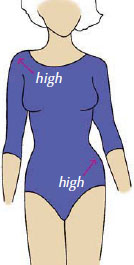
Take only ONE measurement (hip) to buy the right size pattern. No more measuring every inch of your body. No more sitting on a chair to take the crotch measurement. Why? Because these don’t work.


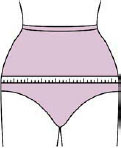
Don’t measure the tummy area, because even if it is larger, you can leave out the darts and add to the waist at the sides and center front.
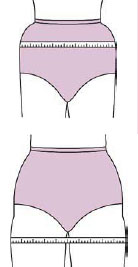
Don’t measure the thighs. If you are fuller below the crotch, don’t worry. In pants, you can let out both the side seams and inseams for full thighs.
If you are between sizes, select the smaller size unless the garment is VERY fitted. Pattern companies generally add enough ease to cover you until you get to the next size.
However, if you are flat in the back, go one to two sizes larger so you will have enough room to take a tuck out of the back to reduce the back width and still have the side seam at your side. (See page 31.) With multisized patterns you can always cut one or two sizes larger since you can always make it smaller when tissue-fitting.

If the pattern doesn’t come in your size or you have bought a coordinates pattern to fit your top, and the bottom included in the pattern is not your bottom size, don’t worry. Understanding grading should make you more comfortable sewing with any size. True pant grading to enlarge a pattern might look like the illustration below.
Most sizes gain about 2″ in width, but look at how little is gained in the crotch depth or length. If you are LONG in the crotch, you could sew three sizes larger and still not have enough crotch room.

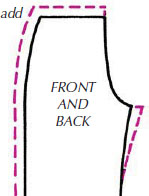
If the pattern is not large enough, you can add to the sides seams, inseams, and at the top.
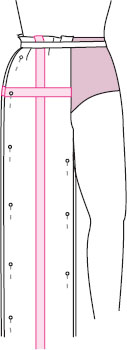
Or you can cut the pattern and spread it, adding as much tissue as you’d like.
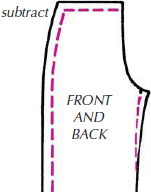
If the pattern is not small enough, subtract from side seams, inseams, and at the top.
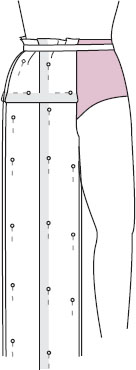
OR you can try on the tissue and tuck it where needed until it fits.
The difference between the size of your pants and your body is called “ease.” Pattern companies automatically add ease to body measurements.
Width—All pattern companies allow a standard minimum comfort ease of 1″ in the waist and 2″ in the hips.
Crotch Depth—Pattern companies allow a standard comfort ease of 3/4″ in the crotch depth. This means pants will hang down 3/4″ from the body.
Your pattern should be larger than your body by these amounts.

The amount of ease that you find comfortable varies with your size and the way you like clothes to fit. We have found that short people and very large people like less fabric on their body because it overpowers them or makes them look larger.
To find out the amount of ease you prefer, try on various styles of pants in your wardrobe.
Pull all the ease to one side and pinch the excess. If you can pinch 1″, you have 2″ ease since you are pinching double thickness. If you can pinch ½”, that is 1″ ease.

Do you like the amount of ease in each pant? Do the styles differ in the amount of ease? Now lift the pants up and down, to “feel” how far they hang down from your crotch. Do the pants that feel comfortable hang down ½”, 3/4″, or more?
This is the actual amount of ease a designer allows to create a style. Jeans are designed to fit tightly, but for you to be able to bend, the waist has extra ease. Trousers must have a minimum of 4″ of ease or the pleats will pull. A knits-only pattern has minimal ease and relies on the fabric to give. Most culottes have more ease in the crotch than pants, to look more like a skirt. See page 12 for ease amounts in various styles.
If you buy a size 16 for your 40″ hips, the pant will vary in finished hip measurement, depending on the style.
The finished garment measurement for each size is printed right on the tissue. You might choose to trim the tissue to one or two sizes smaller or larger depending on this measurement. Then tissue-fit to make sure you like the size you chose.
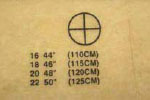

If you are short and a size 16, 9″ of ease may be way too much fabric for your body. You could buy this pattern two sizes smaller. Five inches of ease may still create the “look” of the design on your shorter stature. You may also want to choose a smaller size if the fabric you are using is stiff or bulky. In other words, unless the design requires the full amount of ease, you can change it!
The only size standard of pant manufacturers is “the more you pay, the smaller size you can be.” Pati’s size 18 derriere got into a size 12 Anne Klein. She almost bought them! We call this vanity sizing! Ready-to-wear manufacturers don’t have standards, because you can try on the merchandise before you buy it.
Some ready-to-wear manufacturers design their slopers for a specific audience. Have you noticed that pants for the mature woman are fuller in the waist and flatter in the derriere? Pants for juniors are flat in the front, small in the waist, and full in the derriere. See our book Fit for Real People to read more about size, especially the differences between Women’s, Petite, Half, and Misses’ sizes.
Patterns sold by small (8-10), medium (12-14), and large (16-18) are cut for the larger of the two sizes. Keep this in mind as you are making your size decisions. Always check to see which sizes are actually in each range of small, medium, and large since they may vary from design to design.
Pattern companies have multisize patterns, with cutting lines for several sizes in one pattern. They use less paper, give consumers more size choices, AND save the retailer from needing as many patterns in stock.
Most Palmer/Pletsch McCall’s pant patterns have wider seam allowances as shown at the right. They are called “in-case” seam allowances…larger than normal in case you need more room.

We recommend having 1″ side, inseam, and waist seam allowances on all patterns to allow for fabric variables. You can trim them after fitting if desired.
Pattern companies have standardized sizing because you can’t try on a pattern before you buy it. However, the ease and crotch shape will vary with each design. Some styles may require less altering because of the ease allowed. The computer grades the design, but people actually hand draft every design, so you do get that “human touch,” which might affect the shape and hence your fit. But we have found that if you have “thighus gigantus” in a pattern from one company, you’ll have it in similar-style patterns from another company.
As we mature, our derriere gets lower and flatter due to gravity. Usually our waist thickens due to the space between the vertebrae narrowing. Our tummies get fuller due to relaxing muscle tone. Genetics also plays a role. We decided not to make a flat derriere pattern because the amount of flatness is not standard. Everyone is different!

For these reasons, Palmer/Pletsch patterns have alteration lines drawn on the tissue. In the guide sheet we tell you how to tissue-fit.
If you have carried books, babies, or groceries on one hip for years, your spine may be curved and one hip higher. You might warn your daughters to switch sides so they don’t end up higher on one side!
